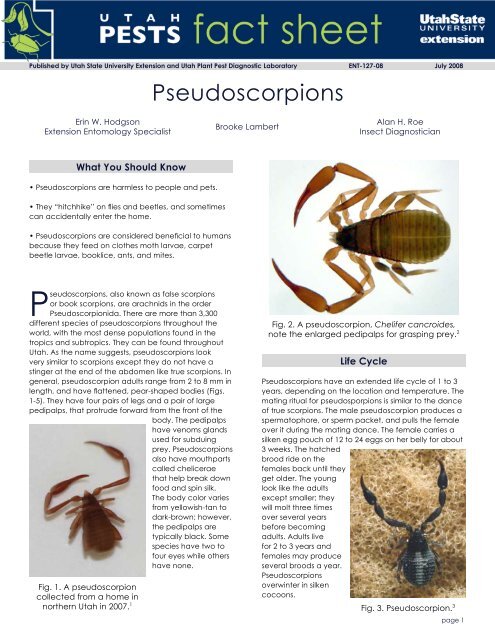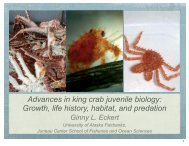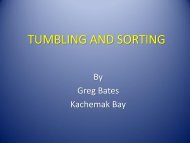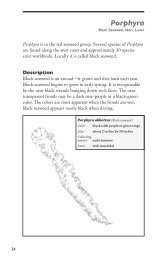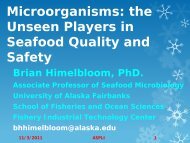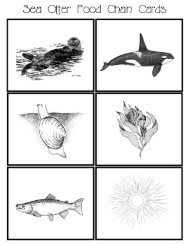Pseudoscorpions
Pseudoscorpions
Pseudoscorpions
Create successful ePaper yourself
Turn your PDF publications into a flip-book with our unique Google optimized e-Paper software.
Published by Utah State University Extension and Utah Plant Pest Diagnostic Laboratory ENT-127-08 July 2008<br />
Erin W. Hodgson<br />
Extension Entomology Specialist<br />
What You Should Know<br />
• <strong>Pseudoscorpions</strong> are harmless to people and pets.<br />
• They “hitchhike” on flies and beetles, and sometimes<br />
can accidentally enter the home.<br />
• <strong>Pseudoscorpions</strong> are considered beneficial to humans<br />
because they feed on clothes moth larvae, carpet<br />
beetle larvae, booklice, ants, and mites.<br />
<strong>Pseudoscorpions</strong>, also known as false scorpions<br />
or book scorpions, are arachnids in the order<br />
Pseudoscorpionida. There are more than 3,300<br />
different species of pseudoscorpions throughout the<br />
world, with the most dense populations found in the<br />
tropics and subtropics. They can be found throughout<br />
Utah. As the name suggests, pseudoscorpions look<br />
very similar to scorpions except they do not have a<br />
stinger at the end of the abdomen like true scorpions. In<br />
general, pseudoscorpion adults range from 2 to 8 mm in<br />
length, and have flattened, pear-shaped bodies (Figs.<br />
1-5). They have four pairs of legs and a pair of large<br />
pedipalps, that protrude forward from the front of the<br />
body. The pedipalps<br />
have venoms glands<br />
used for subduing<br />
prey. <strong>Pseudoscorpions</strong><br />
also have mouthparts<br />
called chelicerae<br />
that help break down<br />
food and spin silk.<br />
The body color varies<br />
from yellowish-tan to<br />
dark-brown; however,<br />
the pedipalps are<br />
typically black. Some<br />
species have two to<br />
four eyes while others<br />
have none.<br />
Fig. . A pseudoscorpion<br />
collected from a home in<br />
northern Utah in 2007.<br />
<strong>Pseudoscorpions</strong><br />
Brooke Lambert<br />
Alan H. Roe<br />
Insect Diagnostician<br />
Fig. 2. A pseudoscorpion, Chelifer cancroides,<br />
note the enlarged pedipalps for grasping prey. 2<br />
Life Cycle<br />
<strong>Pseudoscorpions</strong> have an extended life cycle of 1 to 3<br />
years, depending on the location and temperature. The<br />
mating ritual for pseudosporpions is similar to the dance<br />
of true scorpions. The male pseudoscorpion produces a<br />
spermatophore, or sperm packet, and pulls the female<br />
over it during the mating dance. The female carries a<br />
silken egg pouch of 12 to 24 eggs on her belly for about<br />
3 weeks. The hatched<br />
brood ride on the<br />
females back until they<br />
get older. The young<br />
look like the adults<br />
except smaller; they<br />
will molt three times<br />
over several years<br />
before becoming<br />
adults. Adults live<br />
for 2 to 3 years and<br />
females may produce<br />
several broods a year.<br />
<strong>Pseudoscorpions</strong><br />
overwinter in silken<br />
cocoons.<br />
Fig. 3. Pseudoscorpion. 3<br />
page
UPPDL, 5305 Old Main Hill, Logan UT 84322-5305 T: 435.797.2435 F: 435.797.8197 www.utahpests.usu.edu<br />
Habitat Description<br />
<strong>Pseudoscorpions</strong> are harmless to people and animals.<br />
They normally occur where moisture is present, such<br />
as in sinks, bathtubs, and drains. They have also<br />
been found between book pages and in stacks of<br />
newspapers. Outdoors they have been found in mulch,<br />
moss, leaf litter, under stones, under tree bark, in<br />
manure, and between boards in buildings.<br />
<strong>Pseudoscorpions</strong> are most active during warm days<br />
in the spring, summer, and fall. <strong>Pseudoscorpions</strong> are<br />
common, but not seen or recognized often due to their<br />
size. These arachnids are not very mobile, but they will<br />
attach themselves to the legs of flies, beetles, and other<br />
insects. As they “hitchhike” to new habitat, they can be<br />
accidentally introduced inside structures.<br />
<strong>Pseudoscorpions</strong> cannot bite people or pets and should<br />
be considered beneficial. The young and adults feed<br />
on clothes moth larvae, carpet beetle larvae, booklice,<br />
ants, mites, small flies, and small earthworms. Like true<br />
scorpions, pseudoscorpions inject venom into prey and<br />
ingest the liquefied remains.<br />
Fig. 4. Pseudoscorpion. 4<br />
Image courtesy of Erin Hodgson, Utah State University Extension (www.utahpests.usu.edu).<br />
2 Image courtesy of Chris Buddle (www.biology.ualberta.ca/bsc/news24_1/pseudoscorpions.htm).<br />
3 Image courtesy of Key Gray collection at Oregon State University (www.uidaho.edu/so-id/entomology/Spiders.htm).<br />
4 Images courtesy of the Backyard Arthropod Project (http://somethingscrawlinginmyhair.com/category/arthropods/arachnids/pseudoscorpions/).<br />
5 Image courtesy of Bill Capman (http://www.augsburg.edu/biology/photoofmonth/pseudoscorpion.html).<br />
Management<br />
Control methods for pseudoscorpions are usually not<br />
warranted; however, exclusion of insects and arachnids<br />
in structures is generally encouraged. Efforts should be<br />
made to reduce accidental migration inside the home.<br />
Minimizing pseudoscorpion prey availability will also<br />
discourage infestations.<br />
• Eliminate places where pseudoscorpions live will also<br />
help. Dry out damp areas in the house (e.g., laundry<br />
room, furnace, bathroom, etc.), and around the exterior<br />
perimeter.<br />
• Caulk or seal openings or foundation cracks, windows,<br />
and around plumbing, gas, or electrical conduits.<br />
Use weather stripping around doors and windows.<br />
Expanding-foam sealants may be of value in protecting<br />
hidden recesses and other areas not readily visible.<br />
• Completely sealing any structure may be impossible.<br />
If needed, collect individuals with a broom and dustpan<br />
and discard or simply vacuum any pseudoscorpions<br />
found in the home.<br />
Fig. 5. Size comparison of a dime<br />
and a pseudoscorpion. 5<br />
Precautionary Statement: All pesticides have benefits and risks, however following the label will maximize the benefits and reduce risks. Pay attention to the<br />
directions for use and follow precautionary statements. Pesticide labels are considered legal documents containing instructions and limitations. Inconsistent<br />
use of the product or disregarding the label is a violation of both federal and state laws. The pesticide applicator is legally responsible for proper use.<br />
Utah State University is committed to providing an environment free from harassment and other forms of illegal discrimination based on race, color, religion, sex, national origin,<br />
age (40 and older), disability, and veteran’s status. USU’s policy also prohibits discrimination on the basis of sexual orientation in employment and academic related practices and<br />
decisions. USU employees and students cannot, because of race, color, religion, sex, national origin, age, disability, or veteran’s status, refuse to hire; discharge; promote; demote;<br />
terminate; discriminate in compensation; or discriminate regarding terms, privileges, or conditions of employment, against any person otherwise qualified. Employees and students<br />
also cannot discriminate in the classroom, residence halls, or in on/off campus, USU-sponsored events and activities. This publication is issued in furtherance of Cooperative Extension<br />
work, acts of May 8 and June 30, 1914, in cooperation with the U.S. Department of Agriculture, Noelle E. Cockett, Vice President for Extension and Agriculture, Utah State University.<br />
page 2<br />
page 2


